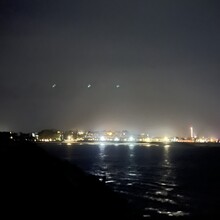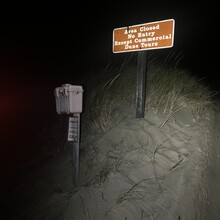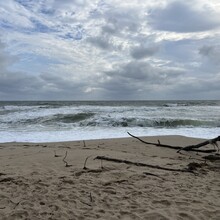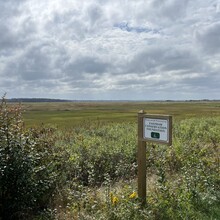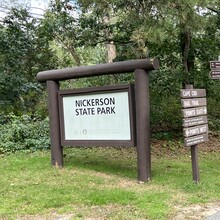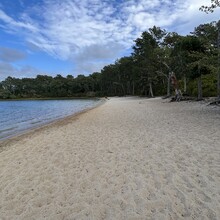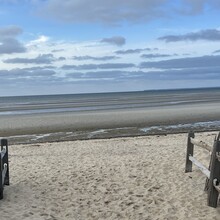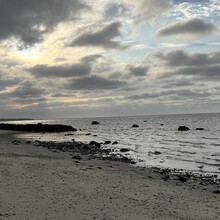Introduction:
On Tuesday, September 26, 2023, amidst high nor'easter winds and pitch-dark conditions, I, Alex Guglielmetti embarked on my second FKT attempt along Cape Cod's picturesque coastline at 12:29 AM. This grueling point-to-point ultra-distance run spanned over 50+ miles and unfolded amidst the enchanting landscapes of Cape Cod. It offered a blend of desert-ultra toughness and the convenience of nearby amenities. What made this endeavor unique was its feasibility only during low tide, demanding precise timing, as reflected in the 12:29 AM start time, and a well-thought-out run strategy.
The Rigors of the Cape Cod's Race Against The Tides Ultra:
Allow me to emphasize the arduous nature of this ultra-distance run. While it didn't feature significant elevation changes, it posed a relentless challenge characterized by sand, including the notorious wet sand. The terrain ranged from energy-sapping soft sand to unpredictable knee-deep water, testing physical and mental strength. Progress in wet sand was slow and occasionally frustrating. Sorting damp sand during ultra-runs can be extremely challenging due to several factors:
- Resistance and Fatigue: Wet sand proved to be incredibly soft and energy-sapping, causing quicker muscle fatigue compared to running on my regular mountain trails.
- Uneven Terrain: Wet sand rarely offers a perfectly flat surface. It can feature ruts, depressions, and varying compaction levels, making it difficult to maintain a consistent stride and balance.
- Footwear Challenges: Running in wet sand saturated my shoes, adding weight and discomfort to the run. I remained mindful of the potential for blisters and chafing, so I packed three pairs of Injinji socks and opted for my regular NB Vongos running shoes instead of trail shoes. Utilizing lightweight Dirty Girl Gaiters proved to be a smart solution to tackle this challenge.
- Mental Toughness: Combining physical challenges with the slow progress in wet sand, especially in the early morning, placed a considerable mental burden. Staying motivated and focused on the race demanded a significant effort. However, the homemade brownies and Farm Stand Salty Chocolate Chips at the end of the first 32-mile all-sand section (stashed in my strategically placed food cache) served as excellent motivators, particularly when running solo and self-supported.
In summary, this course can transform an average 8-12 hour 50-mile run into a grueling 15-20 hour endeavor that demands every ounce of strength and endurance.
Run Highlights:
- Tides Timing (September 26, 2023):
- 02:44 AM: Low Tide (-0.04 ft)
- 09:00 AM: High Tide (9.21 ft)
- 3:02 PM: Low Tide (0.39 ft)
- 9:20 PM: High Tide (10.65 ft)
- Moon phase for September 26th, 2023
- Waxing Gibbous
- Three days before a full moon
- Wind Conditions
- Nor'easter Atlantic 15-20Mph winds. Wind Gusts 30-35Mphs.
- Temperature
- 50-68F, Cloudy
Historical Significance, Titanic, Gravitational Pull, and Tide Timing:
This FKT record is remarkable for the course's rugged and desolate natural beauty and its profound historical significance. Cape Cod holds a unique place in American history as the initial landing point of the Pilgrims in 1620 before they eventually journeyed to Plymouth Rock. Additionally, Cape Cod is home to the Cape Cod Lighthouse, known as Highland Light, which served as the first beacon seen by sailors navigating from Europe to America in the early 1800s. This welcoming sight would greet them after several weeks of challenging navigation across the vast Atlantic Ocean.
Furthermore, Cape Cod's Marconi Beach has its place in history, notably linked to the aftermath of the Titanic disaster in 1912. When the Titanic struck an iceberg and sank on April 15, 1912, one of the earliest distress calls for help was transmitted via wireless telegraphy. The Titanic's radio operators used the ship's wireless equipment to send distress signals that reached coastal wireless stations, including the Marconi station at Marconi Beach, which was approximately one thousand miles away from the site of the tragic shipwreck
The Marconi station played a pivotal role in relaying the distress call and coordinating rescue efforts. It received the Titanic's distress signals and forwarded them to other East Coast stations, including the Chatham, Massachusetts station. This message was then relayed to the RMS Virginian, one of the ships that responded to the Titanic's call for assistance.
However, what truly distinguishes this FKT record in the ultra-running world is the influence of the moon's gravitational pull on the tide. Unlike runs primarily defined by elevation or terrain, this route demands unique preparation centered around the ebb and flow of the tides. It consists of four critical sections, each requiring precise timing and serving as natural cutoff points. In this event, I encountered a tide miscalculation that added an extra hour to my journey. Nevertheless, drawing from my prior FKT experience, I successfully navigated this unexpected challenge during the run.
The Route:
Note: Please keep in mind that the mileage is estimated using Gaia's distance calculations, and actual tracking, especially on long-distance runs, may vary by approximately 5 kilometers (3 miles). The confirmed distance for this run is 92 kilometers, accounting for minor detours to water faucets and GPS shenanigans.
- Cape Cod National Seashore Park (KM 0-52 | Mile 0-32): The journey commenced at Provincetown's Pilgrim's First Landing Park and led me through a rocky path that included the Provincetown Breakwater, Wood End sandbar, and Herring Cove Beach. During mid-low tide, this last section posed minor challenges, requiring careful assessment of the best spot to cross a mandatory water section. As I continued, I encountered the Province land Dunes at 2 AM (Km16 | M10). Navigating in the dark proved challenging, taking a full hour to conquer this 3-mile section. As dawn broke, the high tide caught up with me in the last four miles of this section (Mile 28, Marconi Beach to Coast Guard Mi), resulting in wet shoes and socks. To save time, I decided to run the final 3 miles barefoot and utilized the Coast Guard bathroom services to clean my shoes and feet and change into fresh socks.
- Nauset Trail to Nickerson Park (KM 52-65 | M 32-40): Beyond the National Seashore, I navigated the beautifully manicured Nauset Trail, retrieving a food cache at the Salt Pond Visitor Center. This trail led me to First Encounter Beach, on the inner Cape Cod Bay side, a pivotal spot where tidal timing was crucial. Several areas, including the Herring River Mash, the Rock Harbor Marsh, and Skaket Beach, two and a half hours before low tide, were submerged under knee to hip-high water. This 2-3 mile section took an hour to clear. Due to tricky quicksand-like conditions, I was cautious not to approach the deep marsh section.
- Nickerson State Park (KM 65-78 | M 40-48): Nickerson State Park offered a much-needed break from the soft sand and water wading. I seized the opportunity to refresh my shoes and feet with clean water and put on my third and final pair of fresh socks. The impeccably maintained, flat trails meandering around the captivating labyrinth of kettle ponds provided a pleasant change of pace. Due to a developing tendon inflammation, I opted for brisk walking during this section, relying on GPS for navigation, which presented no challenges.
- Brewster Tidal Flats (KM 78-86 | M 48-53): This section was a breeze, thanks to low tide, and claimed to be the most extensive tidal flats in the United States. I swiftly covered this 4–5-mile stretch on flat packed sand bars and tide pools, even checking out Brewster Oyster Farms. The cloud-covered sunset accompanied me as I completed this section, leading to the finish line, a refreshing outdoor shower, and a delightful buttery squash chili soup waiting for me at the Sea Meadow Inn. With my new record in hand, I crossed the finish line with a broad smile and a runner's high.
Conclusion:
As I reflect on this challenging journey, I've identified several areas for improvement in future attempts. Initiating the run precisely at low tide would provide ample time to avoid getting caught by waves at Marconi Beach (Mile 28) and navigate the First Encounter section (Mile 32) more efficiently. Additionally, avoiding full and low moon cycles when possible would result in more moderate high tides, facilitating smoother passage through the Cliff sections near Marconi Beach.
This unique challenge along the Massachusetts Coast, shaped by the moon's tides, offers an unmatched experience for endurance runners, seamlessly blending natural beauty with precise timing to evade nature-imposed cutoff times
I extend my heartfelt gratitude to my witness, Mike Archer. I hope my journey inspires others to embrace unique challenges and redefine the boundaries of rugged, all-sand solo endurance running.

